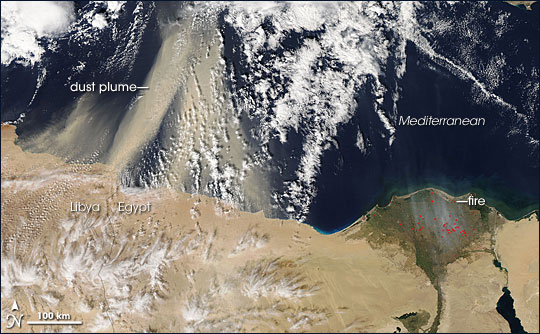
ABC(t) team
The ABC(t) (Atmosphère-Biosphère-Climatologie par télédétection) team studies climatic variables by analysing atmospheric and surface radiation, using active and passive remote sensing measurements from the ground and space.
The ABC(t) (Atmosphere-Biosphere-Climatology by remote sensing) : team central theme is the study of climatic variables and processes based on the analysis of radiation emitted and scattered by the atmosphere and the surface, by active and passive remote sensing from the ground and space. In particular, the team has internationally recognised expertise in the analysis of multi-spectral satellite observations and in the development of innovative instruments, based on in-depth knowledge of spectroscopy, advanced modelling of direct and inverse radiative transfer, calibration/validation, various inverse methods (Bayesian, neuronal, etc.), analysis of data over long time series. The resulting restitution and understanding of atmospheric and surface variables is an essential resource for the study of climate variability and evolution as well as for the study of the planet’s radiation balance. They also represent key data for the validation of general circulation models. The scientific themes of the team focus on the study of the characterisation of the atmosphere and continental surfaces using the coupling of passive infrared sounders (at nadir and limbus) and active instruments (lidars): characterisation of greenhouse gases (CO2, CH4, H2O), clouds, dust aerosols and the radiative properties of continental surfaces. In line with its scientific expertise and research themes, the team is strongly involved in the proposal, preparation and operation of space missions, in particular with CNES and ESA. It coordinates activities around the IASI, IASI-NG and Merlin missions, and participates in the MicroCarb, Flex and GeoCarb mission groups.

DPAO team
The DPAO (Dynamique et Physique de l’Atmosphère et de l’Océan) team studies the fundamental mechanisms of the dynamics and physics of geophysical fluids (atmosphere and ocean), from the turbulent to the planetary scale.
The DPAO team studies the dynamics and physics of the Earth’s fluid envelopes, atmosphere and ocean, from the turbulent to the planetary scale. It analyzes the mechanisms using a rich array of observation tools (satellite, measurement campaigns), and a hierarchy of theoretical and numerical models.
Among the fundamental geophysical structures of interest to the team’s researchers are atmospheric and oceanic eddy structures. In the ocean, the subjects of study focus on the role of these structures in heat transfer, biogeochemical cycles and interactions with the atmosphere. For the atmosphere, current research focuses on the coupling between the organisation of convection and the formation of tropical cyclones, the evolution of extra-tropical cyclones from the Mediterranean basin to the polar seas, as well as on the link between stratospheric anticyclones of synoptic to global scale and aerosols from forest fires.
More generally, turbulence in geophysical fluids is a central object of study in the team, which is involved in theoretical and observational advances on various aspects ranging from oceanic turbulence to convective clouds and their impact on the Earth’s radiation balance.
Another aspect of the dynamics at the heart of DPAO’s work is that of atmospheric oscillations of various scales. Gravity waves emitted by convective clouds, mountains or flow instabilities are studied in terms of their impact on cloud variability and stratospheric circulation. The team is also interested in the large-scale waves responsible for synoptic and seasonal variability at mid and polar latitudes, as well as climate oscillations and their effects in the context of global change.
To make progress on these aspects, DPAO researchers combine advanced conceptual and numerical modeling approaches with ambitious experimental research including laboratory experiments, new satellite measurements and measurement campaigns at sea, in airborne and under balloons. They focus on quantifying the roles of these processes in the climate system and design new approaches to represent them in models and assess their impacts on weather forecasting. As such, the team contributes to the development of various components of the IPSL climate model and to the evaluation of climate models.

EMC3 team
The EMC3 (Etude et Modélisation du climat et du changement climatique) team develops the general circulation model LMDz and studies the physical mechanisms that control the dynamics of climate and climate change.
The EMC3 (Etude et Modélisation du climat et du changement climatique) team:
EMC3 is one of the research groups of Laboratoire de Météorologie Dynamique (LMD). The activities of the EMC3 team are motivated by the desire to improve our understanding of the physical processes that govern the mean state and variability of the climate and to anticipate its future evolution. To this end, the team relies on a variety of observations and models, both in terms of resolution and complexity. Thus, our team is structured in 3 axes:
- Study of the physical mechanisms that control climate variability and sensitivity, based on various observations and models.
To understand the mechanisms at play, the team relies on the analysis of observations; it has long played a leading role in the analysis of space observations, and is playing an increasing role in the analysis of in-situ observations collected at instrumented sites or during field campaigns in the tropics or in Antarctica. On the other hand, the team operates a hierarchy of models ranging from conceptual models to high-resolution models resolving cloud dynamics, in idealized or realistic configurations. - Development of the LMDZ General Circulation Model, the atmospheric component of the IPSL Earth System Model.
A particular emphasis is placed on the development of “physical parameterizations”: mathematically and physically consistent formulations of processes that are too fine-scale to be explicitly represented at model resolution. This concerns in particular cloudy processes and exchanges with continental surfaces. The development of parameterizations feeds on the process studies of the previous axis and translates it into a coherent and unified framework. In return, the analysis of simulations produced with LMDZ in a variety of configurations (global, regional, coupled or not with surfaces, etc.) contributes to shedding light on the role and climatic importance of the various processes involved. - Anticipation of climate change at global and regional scales, in order to help shed light on the societal issues that arise in the face of climate change.
In particular, the team plays a leading role in the analysis of climate sensitivity and the feedbacks that contribute to it, in the preparation of IPCC reports and in a number of expert studies on climate change at different scales. It proposes original solutions for impact studies at regional and local scales.The team has strong links with the small-scale modelling, uncertainty quantification, global atmosphere and continental surface modelling and observation communities.
These activities are carried out in collaboration with many individuals or centers and many projects across IPSL (Pôle de modélisation, Labex), France, Europe and throughout the world. The group plays a leading role in several international projects, and provides a major contribution to national and international assessments on climate change, including the IPCC.

InTro team
The InTro (Interfaces et troposphère) team studies at the regional level the fine-scale physico-chemical processes and their impact on the climate.
Assessing and predicting the impact of climate variability/change on energy systems
The energy sector is significantly affected by meteorological conditions: through the thermal sensitivity of the energy consumption (heating/cooling), the conversion of variable renewable energy (solar/wind) and damages caused by extreme events on assets. In return, most energy sources in the world and in France being fossil fuels, energy use is the largest contribution to global warming. Many research questions thus emerge at the crossroad between climate science and energy engineering and economics. Tackling these issues is made more critical by the need to reduce the greenhouse gas emissions of the energy sector. The InTro team addresses some of these questions as part of the Energy 4 Climate (E4C) center.
Chemistry and transport of atmospheric pollutants from urban to hemispheric scales
The study of the atmospheric composition is an important research topic in the InTRo team. In particular, the team coordinates the development of the CHIMERE chemistry-transport model, which is largely used in France and abroad for research and operational air quality simulations, including the French and European forecast platforms Prev’Air and CAMS. The main topics of research in this field include wildfire emissions with the development of the APIFLAME model, mineral dust emissions from arid areas and their subsequent transport, the transport of volcanic plumes as well as the development of downscaling techniques to address urban scale atmospheric pollution and population exposure with the EXPLUME model.
Regional climate and water cycle
Study of the Water cycle in InTRo is focused on the Mediterranean region, in the framework of international initiatives HyMEx and MedCORDEX. South America has become recently a new priority and builds on collaborations with the University of Buenos Aires. In the Mediterranean area, studies of the hydrological cycle and hydrological extremes (extreme precipitation, dry spells) has relied in part on the RegIPSL regional coupled modelling platform, under development in the InTRo team in collaboration with other IPSL teams. Scientific focuses in the team include interactions between aerosols and precipitation, studying the water cycle of major hydrologic basins. A particular focus is the anthropogenic use of the water and areas of strong surface/atmosphere interactions like the wetlands of the Pantanal in South America. Study of the regional water cycle is one of the strong reasons why the InTRo team is currently strongly involved in the development of the
In collaboration with other teams at LMD and IPSL, the Intro team is a core contributor to the development of a new dynamical core (fluid solver) for LMDZ, the atmospheric general circulation model (GCM) part of IPSL-CM Earth System Model. The main role of DYNAMICO is to reformulate in LMDZ the horizontal advection and dynamics on an icosahedral grid, while preserving or improving their qualities with respect to accuracy, conservation laws and wave dispersion. Efficient implementation on present and future supercomputing architectures is also a key issue addressed by DYNAMICO. A grid refinement strategy based on variable-resolution, fully unstructured meshes is under development. A broader goal is to revisit all fundamental features of the dynamical core, especially the shallow-atmosphere/traditional approximation, the vertical coordinate and the coupling with physics.

Image source: earthobservatory.nasa.gov
Image credit: NASA image courtesy Jeff Schmaltz, MODIS Rapid Response Team at NASA GSFC.

Planéto team
Thea Planéto (Planétologie) team studies the planetary atmospheres of the Solar System as exoplanets, by modelling processes at different scales and by supporting space missions and the analysis and interpretation of their data.
The Planéto (Planétologie) team brings together research activities concerning atmospheres other than that of the Earth. The team’s subjects of study are, on the one hand, the physics and dynamics of the various atmospheres of the solar system and exoplanets, and, on the other hand, the investigation of the evolution of these systems and the origins of life. These activities are supported by the development of models, in the same way as for the study of the Earth: Global Climate Model (LMDz), but also smaller scale models (large-vortex simulations, mesoscale models). The team is also involved in space research, through support for instrument development, mission preparation and data analysis. Although the main objects of study are the atmospheres of the planets and telluric satellites of the solar system (Mars, Venus, Titan), the team also studies the atmospheres of giant planets (Saturn, Jupiter), past climates to explore the evolution of these various atmospheres, the finer and colder atmospheres of the outer solar system (Pluto, Triton), and finally the diversity of the atmospheres of extrasolar planets whose discovery and study are in full expansion phase.

SIRTA team
The SIRTA team aims to document the long-term radiative, physical and dynamic processes in the atmosphere, in particular those related to clouds and their precursors such as aerosols and water vapour.
The SIRTA team takes care of the national multi-instrumental observatory dedicated to the observation of the atmosphere, located at the Ecole Polytechnique. The SIRTA was founded in 1999 on the initiative of the IPSL to federate the research (fundamental or applied) and teaching activities of laboratories in the Paris region in the fields of atmospheric instrumentation and measurements. The SIRTA is a reference tool at the European and international levels. With regard to the contribution of the LMD to the SIRTA operation in terms of technical support and scientific research, a team dedicated to the LMD is studying more particularly the impacts of clouds on the regional climate, the processes driving winter low clouds and fog and summer convective clouds that can create violent thunderstorms, the nature of the different sources of aerosols encountered in the Paris region and the impact of aerosols and clouds on the variability and predictability of photovoltaic electricity production in real conditions.


